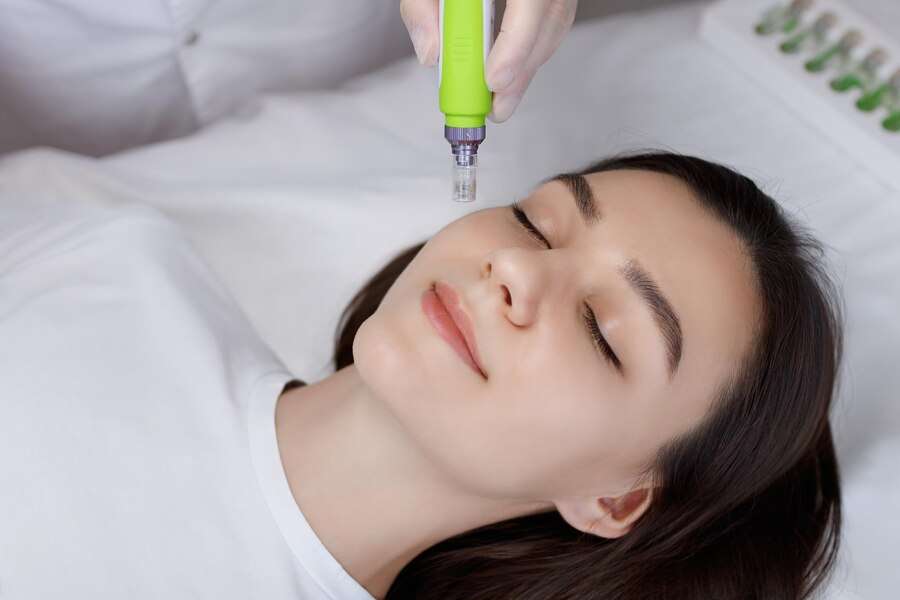Microneedling Benefits for Acne Scars

Microneedling Benefits for Acne Scars
Acne scars can be more than just a reminder of past breakouts; they can impact self-confidence and make achieving smooth, radiant skin feel like an impossible feat. However, in the realm of dermatological advancements, there’s a revolutionary treatment that’s been making waves for its transformative effects: microneedling.
Offering hope to those plagued by the remnants of acne, microneedling has emerged as a promising solution, garnering attention for its ability to rejuvenate the skin and diminish the appearance of scars.
In this blog, we delve into the intricacies of microneedling and explore its myriad benefits in the quest for smoother, clearer skin, particularly for those battling the aftermath of acne.
Understanding Acne Scars: Types and Causes
Acne scars come in various forms, each with its own unique characteristics and underlying causes. The most common types include atrophic scars, which result from a loss of tissue, and hypertrophic scars, characterized by excess tissue formation.
These scars develop as a result of inflammatory acne lesions, where the skin’s natural healing process is disrupted, leading to abnormal collagen production. Additionally, post-inflammatory hyperpigmentation (PIH) can occur, leaving behind dark marks on the skin after acne resolves.
Understanding the specific type and cause of acne scars is crucial for devising an effective treatment plan tailored to individual needs, whether through microneedling, topical therapies, or other modalities.
The Science Behind Microneedling: How Does it Work?
Microneedling, also known as collagen induction therapy, operates on the principle of controlled micro-injuries to stimulate the skin’s natural healing response. During the procedure, fine needles penetrate the skin’s surface at varying depths, creating microscopic channels. This process triggers the production of collagen and elastin, essential proteins that promote skin regeneration and repair.
Additionally, microneedling enhances the absorption of topical treatments, allowing for better penetration of serums or growth factors into the deeper layers of the skin. As the skin undergoes remodeling, the appearance of acne scars diminishes gradually, replaced by smoother, more even-toned skin. Understanding the intricate mechanisms behind microneedling underscores its efficacy as a transformative treatment for acne scars.
Stimulating Collagen Production: Key to Scar Reduction
Collagen serves as the foundation of healthy skin, providing structure, firmness, and resilience. In the context of acne scar reduction, stimulating collagen production is paramount. Microneedling initiates this process by creating controlled micro-injuries, prompting the skin to ramp up collagen synthesis in response to perceived damage.
As collagen fibers regenerate and remodel, the texture of acne scars improves over time, becoming less noticeable and smoother in appearance. Furthermore, the newly formed collagen helps plump up depressed scars, filling in atrophic areas and restoring volume to the skin.
By targeting collagen production, microneedling offers a holistic approach to scar reduction, addressing both the surface texture and underlying structural integrity of the skin.
Customizing Microneedling Treatments for Acne Scars
Customizing microneedling treatments for acne scars is essential for achieving optimal results tailored to each individual’s skin concerns and needs. The process begins with a thorough assessment of the acne scars, including their type, severity, and location, allowing the skincare professional to develop a personalized treatment plan.
Here are some key aspects of customizing microneedling treatments for acne scars:
- Scar Type Identification: Different types of acne scars, such as icepick, rolling, or boxcar scars, require specific approaches for effective treatment. Identifying the scar type helps determine the depth and intensity of microneedling needed to address them effectively.
- Depth of Penetration: Microneedling devices offer adjustable needle depths, allowing for precise targeting of scars at varying depths within the skin. Customizing the depth of penetration ensures that the treatment reaches the underlying layers where collagen remodeling occurs, promoting scar reduction.
- Combination Therapies: Depending on the individual’s skin condition, combining microneedling with other modalities such as topical serums, platelet-rich plasma (PRP), or fractional laser therapy may enhance results synergistically. Customized combination therapies address multiple aspects of scar formation, including collagen production, skin texture, and pigmentation.
- Treatment Frequency and Duration: The frequency and number of microneedling sessions needed to achieve desired results vary based on the severity of acne scars and individual skin response. Customizing the treatment schedule ensures gradual improvement while minimizing downtime and potential side effects.
- Post-Treatment Care: Tailored post-treatment care, including skincare products and sun protection, is essential for optimizing results and promoting skin healing. Customized recommendations help maintain skin hydration, reduce inflammation, and protect against UV damage, supporting the skin’s recovery process post-microneedling.
By customizing microneedling treatments for acne scars, skincare professionals can address individual concerns effectively, providing personalized solutions for smoother, rejuvenated skin.
Safety and Efficacy: What Research Says About Microneedling
The safety and efficacy of microneedling for acne scars have been extensively studied, with a growing body of evidence supporting its use as a reliable treatment modality. Clinical trials and research studies have demonstrated the ability of microneedling to improve the appearance of acne scars across various skin types and ethnicities, with minimal risk of adverse effects when performed by trained professionals.
Moreover, advancements in technology and technique refinement have further enhanced the safety profile of microneedling procedures, ensuring predictable outcomes and patient satisfaction. As research continues to elucidate the mechanisms and benefits of microneedling, it solidifies its position as a valuable tool in the armamentarium against acne scars.
Combining Microneedling with Other Treatments for Enhanced Results
While microneedling yields impressive results on its own, combining it with complementary treatments can amplify its efficacy for acne scar reduction. Synergistic approaches may include adjunctive therapies such as platelet-rich plasma (PRP), which harnesses the healing properties of growth factors found in the patient’s blood to accelerate tissue repair and collagen synthesis.
Additionally, incorporating topical agents like vitamin C serums or retinoids can enhance the rejuvenating effects of microneedling, promoting collagen production and skin renewal. By integrating multiple modalities, clinicians can tailor treatment regimens to target different aspects of scar remodeling, maximizing improvements in texture, tone, and overall skin quality.
Minimizing Downtime: Recovery Tips After Microneedling
After undergoing microneedling treatment for acne scars, it’s essential to prioritize proper post-procedure care to minimize downtime and maximize results. Here are some recovery tips to help you navigate the healing process effectively:
Recovery Tips:
- Keep the treated area clean and avoid touching it unnecessarily to reduce the risk of infection.
- Apply a gentle moisturizer or soothing serum recommended by your skincare professional to keep the skin hydrated and promote healing.
- Protect your skin from direct sun exposure by wearing a broad-spectrum sunscreen with SPF 30 or higher, as the skin may be more sensitive to UV radiation post-treatment.
- Avoid strenuous exercise and activities that cause excessive sweating for at least 24 to 48 hours to prevent irritation and discomfort.
- Refrain from using harsh skincare products, exfoliants, or retinoids until your skin has fully healed to avoid aggravating sensitivity.
- Follow any additional post-care instructions provided by your dermatologist or skincare specialist to ensure optimal recovery and long-term results.
By adhering to these recovery tips and giving your skin the care it needs, you can promote a smooth and comfortable healing process after microneedling, allowing you to enjoy the benefits of clearer, rejuvenated skin sooner.
Long-Term Benefits: Sustaining Results Beyond the Treatment
One of the remarkable aspects of microneedling for acne scars is its potential for long-term benefits that extend well beyond the immediate post-treatment period. As collagen continues to remodel and regenerate over several months, improvements in scar texture and appearance become more pronounced, with results persisting over time.
Moreover, the stimulation of collagen synthesis induced by microneedling contributes to ongoing skin rejuvenation, promoting elasticity, firmness, and overall skin health. By incorporating microneedling into a comprehensive skincare regimen, individuals can maintain and enhance the results achieved, enjoying smoother, more radiant skin for the long haul.
Addressing Common Concerns: Pain, Side Effects, and Risks
Despite its efficacy, individuals considering microneedling for acne scars may have concerns regarding potential discomfort, side effects, or risks associated with the procedure. While microneedling is generally well-tolerated, it’s not uncommon to experience mild discomfort during the treatment, which can be mitigated with topical numbing creams or anesthesia. Additionally, temporary side effects such as redness, swelling, and minor bruising may occur following the procedure, typically resolving within a few days.
Serious complications are rare when performed by qualified professionals in a controlled setting, with proper adherence to sterile technique and patient selection criteria. Addressing these common concerns through education and transparent communication helps alleviate anxiety and empower individuals to make informed decisions about their skincare journey.
As we wrap up our exploration of microneedling benefits for acne scars, it’s evident that this innovative treatment holds tremendous promise in revitalizing skin affected by acne blemishes. From understanding the intricacies of acne scars to delving into the science behind microneedling, we’ve uncovered the transformative power of stimulating collagen production and customizing treatments for optimal results.
Ready to embark on your journey to smoother, clearer skin? Reach out to American Laser Med Spa, located in Midland, TX, at 432-689-7546 or via email at Midland@americanlaser-medspa.com. Their team of skilled professionals is dedicated to providing personalized microneedling treatments tailored to your unique skin concerns.
Whether you’re seeking to diminish the appearance of acne scars or revitalize your skin’s texture, American Laser Med Spa offers a range of services to help you achieve your skincare goals. Take the first step towards renewed confidence and schedule your microneedling consultation today.







